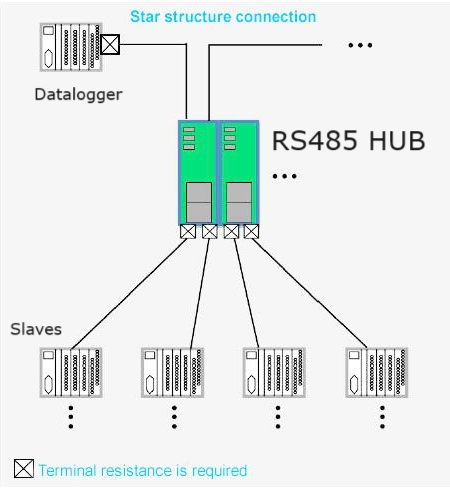Optimizing Solar Power Plant Communication using RS485 Hub
For the efficient and reliable operation of the solar power plant monitoring facilities heavily relies on effective communication and monitoring systems. One common issue that solar power plant operators face is modbus communication problems at their remote monitoring sites. This article discusses the challenges faced by our customers and why we recommend the use of RS485 hubs to address these issues.
Understanding the Modbus Communication Challenge: Modbus is a popular communication protocol used in many industrial applications, including solar power plants. It allows for the exchange of data between various devices and components within the plant. However, the complexity of a solar power plant’s communication network can lead to issues, particularly when the wiring configuration is not optimized.
One common problem that we encountered at multiple solar power plant remote monitoring sites was the star wiring configuration. In a star configuration, all devices are connected to a central point, which can create bottlenecks and signal degradation. This setup can lead to data transmission errors, communication delays, and overall system inefficiency.
RS485 Hub Solution: To tackle these issues, we recommend the use of RS485 hubs. An RS485 hub is a device that allows multiple RS485 devices to connect and communicate effectively, even in star wiring configurations. Here’s why we suggest its use:
- Improved Data Transmission: RS485 hubs enhance the signal quality and ensure a consistent flow of data between devices. This reduces the likelihood of communication errors and data loss.
- Enhanced Network Scalability: Solar power plants often require the addition of more devices and sensors as they expand. RS485 hubs simplify the integration of new devices, making the network more flexible and scalable.
- Cable Length Compensation: RS485 hubs can extend the maximum cable length between devices, making them suitable for large solar power plant installations.
- Ground loops and common mode voltage offsets: It can be a real headache in communication systems. Fortunately, the RS485 hub has a clever solution to tackle these issues. Each port on the RS485 is electrically isolated. This means that the receiving end can float at the same electrical level as the transmitter’s ground, effectively eliminating common mode offsets and any noise that might be caused by ground loops between different devices.
- Improved Reliability: RS485 hubs minimize downtime and improve the overall reliability of the communication network, ensuring that vital data is always accessible.
Factors to Consider
It’s essential to note that the need for an RS485 hub can vary depending on site-specific factors. Several considerations come into play when deciding if an RS485 hub is necessary:
- Cable Quality: The quality of the communication cables used in the installation can affect signal integrity. Lower-quality cables may benefit from the signal-boosting capabilities of an RS485 hub.
- Network Complexity: The complexity of the solar power plant’s communication network and the distance between devices play a significant role. In cases of star wiring or extensive networks, an RS485 hub is often beneficial.
- Expansion Plans: Consider the potential for future expansion. If the plant is expected to grow, using an RS485 hub from the start can save time and effort when adding new devices.

